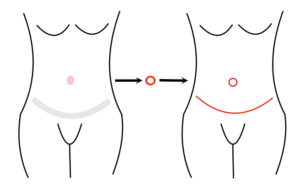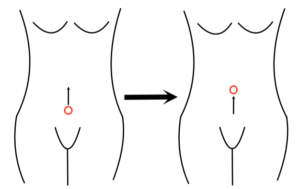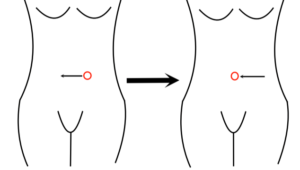 If you are one of our many patients interested in undergoing tummy tuck surgery (abdominoplasty), you may be wondering what happens to the belly button (umbilicus) during this popular cosmetic procedure. Various maneuvers are available to improve the appearance of the belly button at the same time as tummy tuck surgery. In most cases, the surgeon aims to relocate the navel to the correct anatomic position in order to restore a more youthful appearance.
If you are one of our many patients interested in undergoing tummy tuck surgery (abdominoplasty), you may be wondering what happens to the belly button (umbilicus) during this popular cosmetic procedure. Various maneuvers are available to improve the appearance of the belly button at the same time as tummy tuck surgery. In most cases, the surgeon aims to relocate the navel to the correct anatomic position in order to restore a more youthful appearance.
The formal term for the surgical enhancement of the belly button is “umbilicoplasty.” While it is often performed in conjunction with the “full” tummy tuck, umbilicoplasty may or may not be incorporated into other abdominoplasty techniques, such as the “mini” tummy tuck. Please explore the following images to learn more about your options for umbilicoplasty.
The belly button can be left attached to the abdominal wall, or it can be removed from the body and “replanted.” During most abdominoplasties, the belly button is left attached to the abdominal wall, as seen below in an intraoperative image.

In much less common circumstances, the belly button may be removed from the body wall and replaced in the normal position as a “free graft.”

If the belly button is too low as a result of abdominal (panniculus) sagging, it can be elevated to the correct position during the procedure. This is diagrammatically illustrated in the image below.

If the belly button has lateral asymmetry (in other words, if it is too far to the right or left), your surgeon can move it to the midline during the abdominoplasty, as illustrated in the image below.

In many patients, the belly button is “collapsed” and wrinkled, meaning the tissue has become loose (lax). In virtually all “full” tummy tuck procedures, the belly button is tightened, meaning it is “stretched” back out to its normal shape. Similar to many skin tightening procedures, the excess skin of the belly button is tightened so that the appearance is more youthful.
To learn more about abdominoplasty or schedule a consultation, please don’t hesitate to contact Stephen Herring, MD today. Dr. Herring is a board-certified plastic surgeon renowned for his ability to tailor each abdominoplasty to the unique anatomy of the patient. Whether you live locally or are traveling from out of town, he is happy to discuss your goals and possible solutions.
Previous Post Next Post